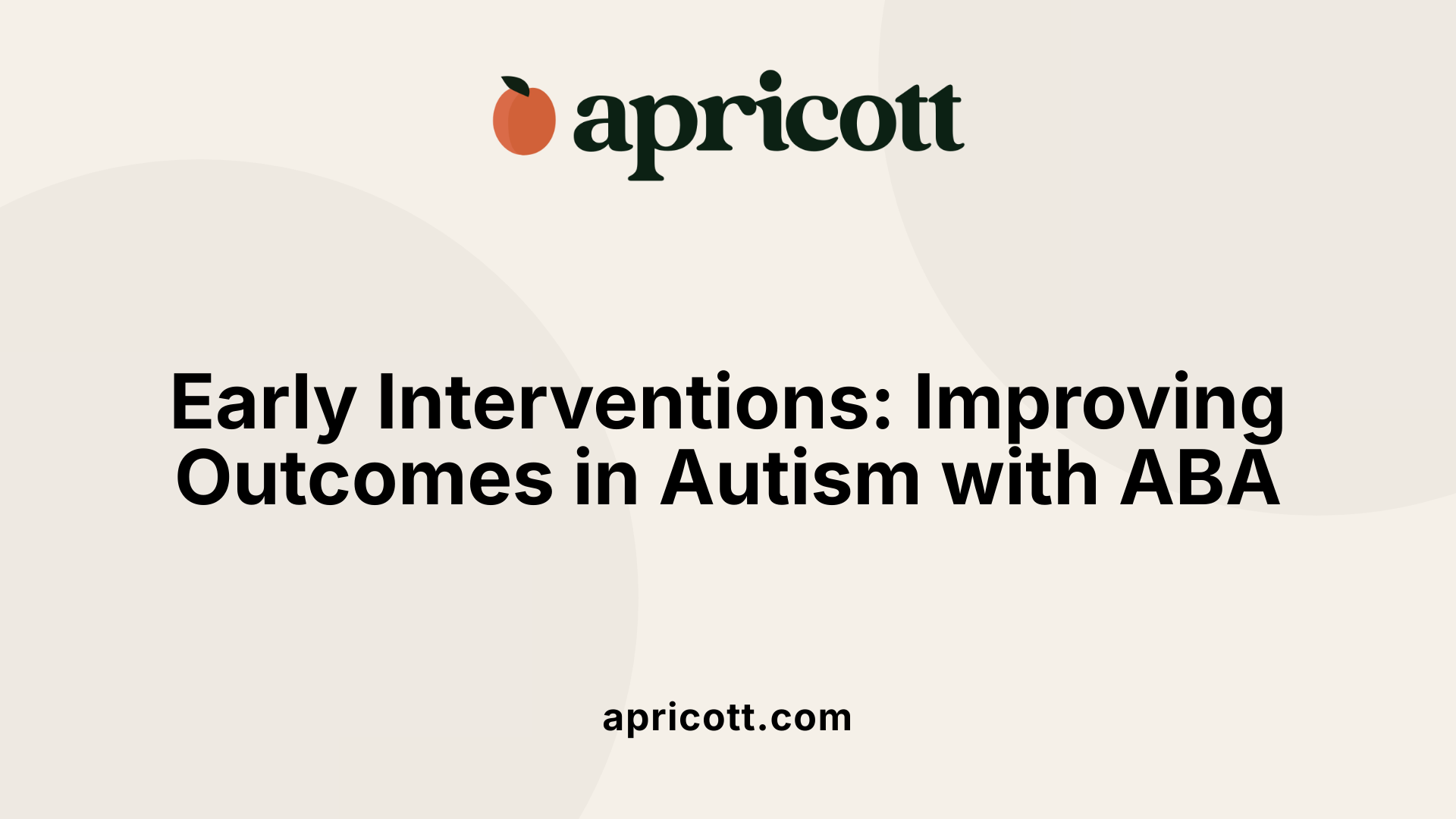December 2, 2025
Understanding the Comprehensive Approach to Autism Therapy
The term 'Autism Wheel' often refers to the broad spectrum of autism-related characteristics and therapies designed to support individuals with autism. Central to this concept is the application of behavioral analysis methods that systematically promote skill development and manage challenges. This article delves into how behavioral therapies—particularly Applied Behavior Analysis (ABA) and its derivatives—play a pivotal role in addressing the diverse needs of individuals with autism.
Therapy grounded in behavioral analysis for autism is designed to understand and alter behaviors to enhance the individual's day-to-day functioning and life quality. It targets teaching important skills such as communication, social engagement, self-care, and academics while minimizing behaviors that disrupt learning or cause harm.
ABA employs positive reinforcement to encourage desirable behaviors and uses careful observation of what triggers behaviors to reduce those that are problematic. This approach tailors interventions specifically to each child's needs and skill levels.
The primary goals of ABA therapy include:
ABA emphasizes promoting independence, empowering the individual to engage more fully in family, school, and community activities.
Behavioral analysis uses several techniques, including:
Therapists create structured learning opportunities and naturalistic settings to practice skills, ensuring consistent reinforcement and gradual improvement.
This comprehensive, data-driven approach has been demonstrated to improve cognitive, social, and language skills effectively in children with autism, supporting their growth towards greater independence and better quality of life.

Applied Behavioral Analysis (ABA) uses carefully structured methods to teach a range of skills by focusing on behaviors that are socially significant. The approach involves breaking down complex skills into smaller parts, providing clear instructions and prompts, and offering repeated practice opportunities—known as trials—to reinforce learning.
Discrete Trial Teaching is a specific ABA technique involving rapid, repetitive instructions aimed at teaching individual skills quickly and efficiently. Each trial has a clear beginning and end, and successful task completion is rewarded, which helps in skill acquisition.
Task analysis breaks down complicated tasks into smaller, manageable steps. Through chaining, these steps are taught in sequence until the entire task is mastered. Prompting is used to guide learners through each step, gradually reducing help as independence develops.
Positive reinforcement is central to ABA therapy. When a learner completes a task successfully or displays a desirable behavior, they receive rewards or praise immediately. This strategy encourages repetition of positive behaviors while reducing unwanted behaviors by removing triggers and redirecting attention towards reinforcing activities.
This combination of methods ensures that learners develop important skills systematically and effectively, promoting independence and generalization of skills across different settings.
Pivotal Response Treatment is a play-based therapy derived from ABA principles. It focuses specifically on improving pivotal areas of behavior, such as motivation and initiation of communication. By targeting these core behaviors, PRT helps children enhance their communication skills, engage in more meaningful play, and improve social interactions.
The Early Start Denver Model (ESDM) is designed for very young children, aged 1 to 4 years. This early intervention approach integrates ABA with developmental and relationship-based techniques to promote social, emotional, cognitive, and language growth. Unlike more structured ABA therapies, ESDM occurs both in clinical settings and at home, embedded naturally in play and daily routines. It involves not only therapists but also parents and family, creating a collaborative environment for skill development.
Play-based therapies like PRT, and early interventions such as ESDM, emphasize naturalistic engagement and motivation. These approaches encourage children to learn through enjoyable, meaningful activities, which can boost participation and reduce resistance. Early intervention capitalizes on critical developmental periods, leading to improved outcomes in language, social skills, and behavior reduction. Furthermore, incorporating family members in therapy enhances generalization of skills across settings.
These advanced ABA-derived treatments enrich traditional ABA by addressing motivation and social initiation through play and applying early, developmentally informed strategies to maximize growth during formative years.
Therapy for autism using behavioral analysis is delivered by a multidisciplinary team of trained professionals. This team often includes Board Certified Behavior Analysts (BCBAs), behavior therapists, speech and language therapists, occupational therapists, physical therapists, psychologists, and clinicians experienced in evidence-based autism interventions. These specialists work together to create personalized treatment plans centered on approaches like Applied Behavioral Analysis (ABA), Pivotal Response Treatment (PRT), and the Early Start Denver Model.
The collaboration between professionals ensures that each child receives comprehensive support targeting various developmental areas. For example, BCBAs typically lead ABA therapy and design interventions that break down skills through task analysis, utilizing techniques such as discrete trial teaching (DTT) and positive reinforcement. Speech therapists focus on enhancing communication abilities, while occupational and physical therapists target sensory processing and motor skills. Psychologists and clinicians contribute assessments and monitor behavioral progress. Parents and family members are also crucial team members, often trained to implement strategies at home, especially in models like Early Start Denver.
Therapy is delivered across a range of environments to support skill generalization and natural learning. Common settings include in-home programs that allow intervention during daily routines and play, specialized clinics equipped for structured sessions, schools to integrate behavioral supports within academic activities, and emerging telehealth services increasing accessibility. The variety of settings and team collaboration aim to foster independence, social development, and reduction of challenging behaviors through scientifically grounded, personalized care.

ABA therapy is designed to teach new skills by breaking them down into small, manageable steps. This approach makes learning more accessible and less overwhelming for children with autism. Therapists provide clear instructions and prompts, guiding the child through each step. Positive reinforcement, such as praise or rewards, follows successful completion of tasks to encourage ongoing progress. This one-on-one, intensive method ensures skills like language and social interaction are effectively developed.
In ABA therapy, reinforcement plays a crucial role beyond teaching new skills. It helps maintain and strengthen existing abilities. Through repeated practice and consistent positive feedback, children are encouraged to continue using learned skills. This reinforcement supports the retention of desirable behaviors and prevents regression. Therapists also use reinforcement to encourage replacement behaviors, helping minimize less desirable actions.
Generalization is a vital aspect of ABA, ensuring children can use skills outside therapy sessions in real-life situations. ABA programs introduce skills in various settings and contexts, including both structured environments and everyday activities. By providing numerous opportunities or trials in different surroundings, children learn to apply what they've acquired more broadly. This process is supported by involving parents and family members in therapy, especially in models like the Early Start Denver Model, bridging the gap between clinic and home environments.
ABA's focus on teaching, reinforcing, and generalizing skills makes it a comprehensive and effective approach for supporting children with autism in their development.

In Applied Behavior Analysis (ABA), a fundamental strategy for behavior management involves adjusting antecedents— the events or conditions that occur before a behavior. By altering these triggers thoughtfully, therapists can reduce the chance that undesirable behaviors will occur. This might involve changing the environment or modifying instructions so that problem behaviors are less likely to be provoked.
Reinforcement is crucial in ABA and involves providing positive outcomes following a desirable behavior to increase its future occurrence. By actively reinforcing positive behaviors and withholding reinforcement for problematic actions, ABA therapists help minimize the frequency and intensity of undesirable behaviors. This targeted use of reinforcers encourages learned behaviors that are socially significant.
Beyond simply reducing negative behaviors, ABA emphasizes teaching replacement behaviors. These are appropriate actions that serve the same function as the problem behavior but are more constructive. Therapists apply reinforcement to these alternative responses, helping children develop useful skills while reducing maladaptive behaviors. This method supports long-term positive behavior change and fosters independence.
By systematically manipulating antecedents and reinforcing appropriate behaviors, ABA creates a supportive learning environment that reduces challenging behaviors while encouraging positive, functional ones for children with autism.
Family participation is a crucial element of Applied Behavior Analysis (ABA) therapy. Parents and family members are actively involved in the therapeutic process to help reinforce skills and promote generalization of behaviors outside clinical settings. By participating in sessions or learning therapeutic techniques, families contribute to consistent and effective intervention.
Therapists collaborate closely with parents, providing training and guidance to implement therapy strategies at home. This partnership ensures that the child receives consistent support across environments, which is essential for maintaining progress. Therapists also communicate regularly with families to tailor interventions based on the child’s needs and family routines.
At-home integration of therapy allows children to practice newly learned skills in everyday situations, enhancing their independence. Models like the Early Start Denver Model specifically involve sessions conducted during play and daily routines with trained therapists alongside parents and family members. This approach empowers families to carry out therapy activities naturally throughout the day.
Engaging parents and families not only supports the child’s advancement but also improves overall satisfaction with ABA programs, fostering a collaborative and inclusive atmosphere for behavioral therapy.

Early behavioral interventions, particularly those based on Applied Behavioral Analysis (ABA), have shown remarkable benefits for young children diagnosed with autism spectrum disorder (ASD). These therapies, often delivered intensively and beginning at an early age, focus on systematically teaching essential skills through small, manageable tasks and positive reinforcement. Such early intervention can influence not only the affected child's development trajectory but also their long-term outcomes in social and cognitive areas.
Research demonstrates that early ABA-based therapy significantly improves multiple developmental domains. Children receiving early intensive ABA interventions show notable gains in cognitive abilities, language acquisition, and social functioning. For instance, early start Denver models and pivotal response treatment use structured play and naturalistic methods to engage children and foster communication and social interactions effectively.
Another key outcome of early intervention is a reduction in repetitive and restricted behaviors common in children with ASD. Through targeted behavioral strategies such as task analysis and discrete trial teaching, therapists identify antecedents of these behaviors and use reinforcement techniques to diminish their occurrence. This structured approach not only curtails disruptive behaviors but also promotes the development of alternative, more adaptive behaviors.
Parents consistently report satisfaction with the social validity and tangible progress resulting from ABA-based programs, underscoring the practical effectiveness of these early behavioral interventions in enhancing children’s everyday functioning and quality of life.
ABA techniques are widely applied in classroom settings to enhance student behavior and promote learning. Through structured interventions like discrete trial teaching and behavioral supports, teachers can address diverse needs by teaching social and academic skills. These strategies help create a positive learning environment and increase student engagement.
In inclusive classrooms where students with various abilities learn together, ABA methods facilitate behavioral improvements for all students. By manipulating antecedents and reinforcers, educators can encourage desirable behaviors and reduce disruptive ones. This leads to a more supportive atmosphere benefiting both students with and without disabilities.
ABA-based programs also focus on reducing bullying by teaching appropriate social interactions and empathy skills. Furthermore, ABA strategies are effective in instructing safety behaviors, equipping children with important skills such as recognizing hazards and following safety rules. These interventions help cultivate safer and more respectful school communities.
ABA's versatility extends well beyond its traditional role in autism therapy. Its evidence-based practices support a wide range of behavioral and educational goals across various settings, proving valuable for improving classroom dynamics, fostering inclusion, and enhancing student safety.
| Application Area | ABA Strategies Used | Benefits Provided |
|---|---|---|
| Classroom Behavior | Discrete trial teaching, behavioral supports | Improved engagement, skill acquisition |
| Inclusive Settings | Manipulation of antecedents and reinforcers | Enhanced behavioral outcomes across diverse groups |
| Bullying Reduction & Safety | Social skills training, safety behavior teaching | Reduced bullying incidents, safer school environment |

Parents of children enrolled in Applied Behavioral Analysis (ABA) programs often express high levels of satisfaction regarding the therapy's impact. Many families appreciate how ABA supports the development of social skills, communication, and everyday independence in their children. This positive feedback highlights the practical benefits families observe from sustained ABA interventions.
Social validity refers to how acceptable and relevant a therapy is to those receiving it. Studies show that ABA programs score highly in social validity, meaning parents and caregivers find the goals, procedures, and outcomes of the therapy meaningful and appropriate for their child's needs. This acceptance is important in fostering ongoing participation and engagement in treatment.
ABA-based interventions have a significant impact on children's educational experiences. They contribute to improved learning outcomes, better classroom behavior, and enhanced social interactions. Parents recognize these improvements, which support inclusion and success in various educational settings. Overall, ABA programs are valued not only for their clinical efficacy but also for their positive influence on children's daily lives and schooling.
Understanding the Autism Wheel concept helps illuminate the extensive and systematic methods used in autism behavioral therapies. Approaches like ABA and its adaptations form the core of evidence-based treatment, focusing on enhancing communication, social interaction, independence, and reducing problematic behaviors. Delivered by a multidisciplinary team and supported by family involvement, these therapies provide individualized strategies that address each unique profile on the autism spectrum. The wide applicability and demonstrated effectiveness of ABA-based interventions affirm their central role in both early and ongoing support for individuals with autism, helping to improve lives and foster meaningful inclusion in society.